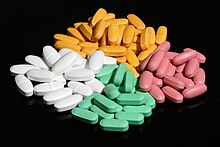Advantages and disadvantages of Tablets
Tablets are simple and convenient to use. They provide an accurately measured dosage of the active ingredient in a convenient portable package, and can be designed to protect unstable medications or disguise unpalatable ingredients. Colored coatings, embossed markings and printing can be used to aid tablet recognition. Manufacturing processes and techniques can provide tablets special properties, for example, sustained release or fast dissolving formulations.
Some drugs may be unsuitable for administration by the oral route. For example, protein drugs such as insulin may be denatured by stomach acids. Such drugs cannot be made into tablets. Some drugs may be deactivated by the liver when they are carried there from the gastrointestinal tract by the hepatic portal vein (the "first pass effect"), making them unsuitable for oral use. Drugs which can be taken sublingually are absorbed through the oral mucosae, so that they bypass the liver and are less susceptible to the first pass effect. The oral bioavailability of some drugs may be low due to poor absorption from the gastrointestinal tract. Such drugs may need to be given in very high doses or by injection. For drugs that need to have rapid onset, or that have severe side effects, the oral route may not be suitable. For example salbutamol, used to treat problems in the pulmonary system, can have effects on the heart and circulation if taken orally; these effects are greatly reduced by inhaling smaller doses direct to the required site of action.
 10:14 AM
10:14 AM
 kotesh
kotesh


